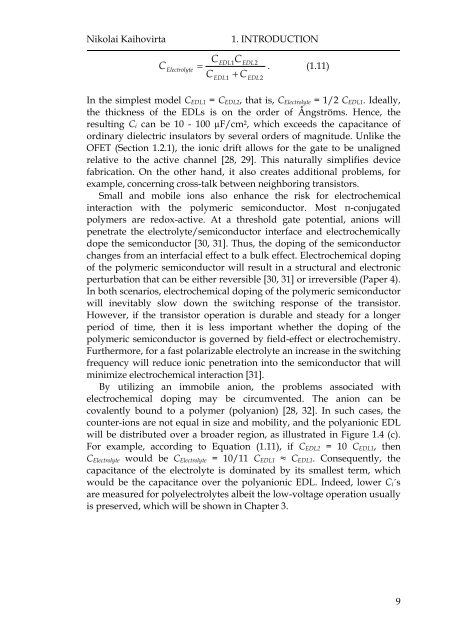ION MODULATED ORGANIC TRANSISTORS - Doria
ION MODULATED ORGANIC TRANSISTORS - Doria
ION MODULATED ORGANIC TRANSISTORS - Doria
- No tags were found...
Create successful ePaper yourself
Turn your PDF publications into a flip-book with our unique Google optimized e-Paper software.
Nikolai KaihovirtaCElectrolyteCCEDL11. INTRODUCT<strong>ION</strong>C+ CEDL1EDL2= . (1.11)EDL2In the simplest model C EDL1 = C EDL2 , that is, C Electrolyte = 1/2 C EDL1 . Ideally,the thickness of the EDLs is on the order of Ångströms. Hence, theresulting C i can be 10 - 100 µF/cm 2 , which exceeds the capacitance ofordinary dielectric insulators by several orders of magnitude. Unlike theOFET (Section 1.2.1), the ionic drift allows for the gate to be unalignedrelative to the active channel [28, 29]. This naturally simplifies devicefabrication. On the other hand, it also creates additional problems, forexample, concerning cross-talk between neighboring transistors.Small and mobile ions also enhance the risk for electrochemicalinteraction with the polymeric semiconductor. Most π-conjugatedpolymers are redox-active. At a threshold gate potential, anions willpenetrate the electrolyte/semiconductor interface and electrochemicallydope the semiconductor [30, 31]. Thus, the doping of the semiconductorchanges from an interfacial effect to a bulk effect. Electrochemical dopingof the polymeric semiconductor will result in a structural and electronicperturbation that can be either reversible [30, 31] or irreversible (Paper 4).In both scenarios, electrochemical doping of the polymeric semiconductorwill inevitably slow down the switching response of the transistor.However, if the transistor operation is durable and steady for a longerperiod of time, then it is less important whether the doping of thepolymeric semiconductor is governed by field-effect or electrochemistry.Furthermore, for a fast polarizable electrolyte an increase in the switchingfrequency will reduce ionic penetration into the semiconductor that willminimize electrochemical interaction [31].By utilizing an immobile anion, the problems associated withelectrochemical doping may be circumvented. The anion can becovalently bound to a polymer (polyanion) [28, 32]. In such cases, thecounter-ions are not equal in size and mobility, and the polyanionic EDLwill be distributed over a broader region, as illustrated in Figure 1.4 (c).For example, according to Equation (1.11), if C EDL2 = 10 C EDL1, thenC Electrolyte would be C Electrolyte = 10/11 C EDL1 ≈ C EDL1 . Consequently, thecapacitance of the electrolyte is dominated by its smallest term, whichwould be the capacitance over the polyanionic EDL. Indeed, lower C i´sare measured for polyelectrolytes albeit the low-voltage operation usuallyis preserved, which will be shown in Chapter 3.9
















